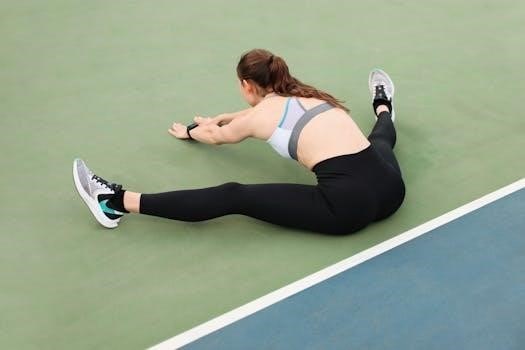Vocal Function Exercises (VFEs) are a structured series of voice exercises designed to strengthen and coordinate the muscles involved in voice production․ Developed by Joseph Stemple, these exercises improve voice efficiency․ VFEs are a well-researched method using daily practice․
What are Vocal Function Exercises (VFEs)?
Vocal Function Exercises (VFEs) are a systematic approach to voice therapy, focusing on improving vocal strength, coordination, and overall function․ Developed by speech-language pathologist Joseph Stemple, VFEs involve a specific set of exercises completed twice daily to target key muscle groups․ These exercises are not just for singers; they benefit anyone seeking to enhance their voice quality and efficiency․ VFEs aim to balance the entire vocal mechanism through consistent practice․ The exercises typically consist of four core components⁚ a warm-up, a stretch, a contraction, and a power exercise․ These components are designed to work together to promote a healthy and resilient voice․ The exercises are often performed using specific vowel sounds and musical notes, and can be tracked with a VFE tracker PDF․ The approach is prescriptive and well-researched, making it a reliable tool in voice therapy․ It’s important to note that these exercises were studied on normal voices, so caution is advised when applying them to disordered populations․

The Science Behind VFEs
VFEs are grounded in principles of muscle strengthening and coordination․ They target specific laryngeal muscles to improve vocal fold function․ Research supports their effectiveness in enhancing voice quality and endurance through consistent practice․
Muscles Targeted in VFEs
Vocal Function Exercises primarily target the intrinsic laryngeal muscles, which are crucial for phonation․ These include the thyroarytenoid, posterior cricoarytenoid, lateral cricoarytenoid, and cricothyroid muscles․ The thyroarytenoid muscles control vocal fold tension and thickness․ The posterior cricoarytenoid muscles are responsible for vocal fold abduction, which is opening the vocal folds․ The lateral cricoarytenoid muscles adduct the vocal folds, bringing them together․ The cricothyroid muscles lengthen and thin the vocal folds, influencing pitch․ VFEs also engage extrinsic laryngeal muscles that support the larynx, like the sternohyoid and thyrohyoid․ By strengthening and improving coordination of these muscles, VFEs enhance vocal efficiency and reduce strain․ These targeted muscle actions directly impact vocal fold vibration and airflow, leading to improved voice production․ The exercises are designed to create balance in the laryngeal system․
How VFEs Improve Voice Function
Vocal Function Exercises improve voice function by systematically strengthening and coordinating the laryngeal muscles․ These exercises enhance vocal fold adduction and abduction, leading to more efficient voice production․ By building muscle strength, VFEs reduce vocal strain and fatigue, allowing for sustained vocalization․ The exercises also improve control over vocal fold tension and airflow, which is vital for pitch variation and loudness․ The consistent practice of VFEs promotes better vocal fold vibration, resulting in improved vocal quality and clarity․ Furthermore, VFEs encourage balance in the vocal mechanism, which helps to prevent vocal issues and disorders․ Through targeted muscle engagement, VFEs optimize the coordination of the entire vocal system, leading to more efficient and healthy vocal performance․ This systematic approach promotes vocal stamina and overall vocal health․ The exercises are designed to create balance in the laryngeal system․

Core VFE Exercises
The core exercises include a warm-up, a stretch, a contract, and a power exercise․ These four exercises are completed twice daily, engaging the voice softly to promote vocal health and stamina․
Warm-up Exercise
The warm-up exercise in Vocal Function Exercises (VFEs) typically involves sustaining a specific vowel sound, often the ‘o’ or ‘u’ vowel, on a comfortable musical note․ This is done to gently awaken the vocal mechanism and prepare it for further activity․ This exercise promotes a steady airflow and stable vocal fold vibration, establishing a baseline for vocal performance․ The warm-up should be performed with a soft, engaged voice, avoiding any strain or tension․ It is crucial to listen to the quality of the sound and ensure that it remains consistent throughout the duration of the note․ This exercise aids in improving the singer’s control over their vocal production, promoting better coordination between breath and voice․ It also serves as a baseline assessment of the individual’s vocal abilities․ It is essential to start softly and gradually․
Stretch Exercise
The stretch exercise in Vocal Function Exercises (VFEs) involves gliding between notes, usually from a low to a high pitch and back down․ This exercise is designed to increase the flexibility and range of the vocal mechanism, particularly the vocal folds and associated muscles․ This movement promotes the lengthening and shortening of the vocal folds, which is essential for accessing different vocal registers․ The glide should be smooth and controlled, avoiding any sudden jumps or breaks in the sound․ It’s important to maintain a consistent tone quality throughout the entire glide, ensuring the voice remains connected and supported․ The goal is to increase the vocal range and improve muscle coordination․ This helps in achieving a more flexible voice, contributing to better vocal performance and overall vocal health․ Remember to keep the airflow steady and to avoid any excessive tension while executing the glide․
Contract Exercise
The contract exercise in Vocal Function Exercises (VFEs) focuses on sustaining specific notes or tones, often using a combination of vowels․ The objective here is to engage and strengthen the muscles responsible for vocal fold adduction, or bringing the vocal folds together․ This is achieved by maintaining a consistent and controlled sound, allowing the muscles to work effectively․ The exercise helps in building endurance and stability in the voice․ It requires the user to hold a specific note with a steady tone and consistent volume, avoiding any wavering or breaks in the sound․ The focus should be on a clear and supported sound with proper breath control․ This exercise plays a vital role in improving the strength and coordination of the vocal mechanism, making it crucial for achieving a more balanced and efficient voice․ This helps in enhancing vocal clarity and reducing vocal fatigue․
Power Exercise
The power exercise in Vocal Function Exercises (VFEs) is designed to enhance vocal projection and endurance․ It involves gliding between notes, which helps to improve the flexibility and responsiveness of the vocal mechanism․ This exercise targets the muscles responsible for controlling pitch and volume, promoting a more dynamic and powerful voice․ The power exercise often combines a specific vowel sound with a musical scale, and the user slides from a low note to a high note and back down again․ This action helps improve the coordination of the muscles involved in pitch change․ Proper execution of this exercise can improve vocal strength and range, allowing for greater control and stamina․ The focus should be on smooth transitions between notes, avoiding any abrupt changes or breaks․ It is crucial to maintain a consistent airflow and supported breath throughout the exercise to achieve optimal results․

Practical Application of VFEs
Integrating Vocal Function Exercises (VFEs) into daily routines is crucial for voice improvement․ Using a tracker can help monitor progress․ Consistency and proper technique are essential for achieving the desired results․
Using a Vocal Function Tracker PDF
A Vocal Function Tracker PDF is an essential tool for individuals engaging in Vocal Function Exercises (VFEs)․ This downloadable resource allows users to meticulously record their daily practice, tracking progress and identifying areas that may require additional focus․ The tracker typically includes space to document the specific exercises performed, the duration for each, and any observations regarding vocal fatigue or improvement․ Using a stopwatch to time exercises is often recommended, and the tracker provides a structured way to keep this information organized․ This visual record of progress serves as a motivator and helps users stay consistent with their practice schedule․ The tracker also aids in recognizing patterns or plateaus in improvement, allowing for necessary adjustments to the VFE regimen․ This PDF is a practical tool that enhances the effectiveness of the vocal training program by promoting self-awareness and accountability in achieving vocal goals․ The act of actively recording helps in remembering the progress․
Integrating VFEs into Daily Practice
Integrating Vocal Function Exercises (VFEs) into daily life requires a commitment to consistency and a strategic approach․ To maximize the benefits, VFEs should be performed twice daily, ideally at a time when the voice is relatively rested․ Many find it helpful to incorporate the exercises as part of their morning or evening routine․ It is important to ensure there is enough time to complete the full sequence of exercises without feeling rushed․ Starting with a warm-up routine before the exercises can also be beneficial․ Setting reminders can help maintain a consistent schedule․ Furthermore, creating a dedicated practice space free from distractions can enhance focus and performance․ It’s crucial to pay attention to vocal cues and adjust the exercises to avoid overexertion or discomfort․ Remember that these exercises are about building strength and coordination gradually․ Over time, the integration of VFEs should become a seamless part of daily vocal health maintenance, contributing to long-term vocal improvement․ The goal is to make it a habit․

Resources for VFEs
Numerous resources are available for Vocal Function Exercises (VFEs), including downloadable PDFs, online demonstrations, and courses․ These resources help people understand and correctly perform the exercises for optimal vocal health․
Where to Find VFE Handouts and PDFs
Locating reliable Vocal Function Exercise (VFE) handouts and PDFs is crucial for effective practice․ Many speech-language pathologists (SLPs) offer free or paid resources online, often including printable PDFs․ Websites associated with universities, such as UKnowledge, may host research papers and theses that include VFE protocols and handouts․ Professional organizations and clinics sometimes share materials as well․ MedBridge offers courses by Joseph Stemple, the developer of VFEs, which may include downloadable resources․ Additionally, some SLPs and therapists on YouTube model the exercises and often link to PDF resources in the video descriptions or their own websites․ Check for free PDF downloads on educational websites, and professional sites that focus on voice therapy․ Remember to confirm the credibility of the source and the information provided before using any downloaded resource․ It’s always recommended to consult an SLP for personalized guidance․
Online Demonstrations of VFEs
Finding online demonstrations of Vocal Function Exercises (VFEs) is a valuable way to learn the proper techniques․ Platforms like YouTube host numerous videos from speech-language pathologists (SLPs) and therapists who demonstrate the exercises․ These demonstrations are helpful for visualizing the movements and understanding the correct form․ Many videos offer step-by-step instructions, making it easier to follow along․ Some online courses, such as those available on MedBridge, also include video demonstrations as part of their training modules․ When searching for demonstrations, look for videos from qualified professionals to ensure you are learning the exercises accurately․ These videos may show how to perform each of the four core exercises⁚ warm-up, stretch, contract, and power․ Pay attention to the vocal quality and body posture displayed in the videos․ Online demonstrations are a great supplementary resource for your VFE practice․